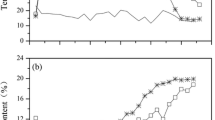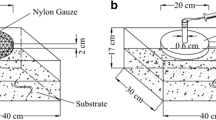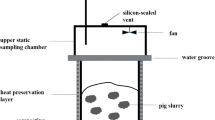Abstract
The intensification of the livestock production systems implies a potential environmental risk, associated with the great generation of animal wastes and slurries and their storage and management. Manure management is associated with considerable emissions of ammonia (NH3) and greenhouse gases (GHG). However, the potential for GHG mitigation is highly dependent on the waste treatment strategy considered. This laboratory study aims to evaluate the influence of the type of bulking agent used on the potential reduction of the carbon dioxide (CO2) emission, dealing with carbon (C) conservation when the solid fraction of pig (Sus scrofa domesticus) slurry is managed by composting. For this, a composting experiment in batch reactors was run with four mixtures elaborated using the solid fraction of pig slurry (SPS) and different materials (maize (Zea mays) stalks, barley (Hordeum vulgare L.) straw, cotton (Gossypium hirsutum) gin and garden prunings) as bulking agents. The potential C conservation in the mixtures was evaluated by determining the CO2 emissions; the evolution of the mixtures, the thermal profile developed and the thermodynamics of the process were also studied. The mixtures elaborated with cotton gin and garden prunings showed the fastest temperature development, and also the highest CO2 emissions. However, the use of maize stalks as bulking agent reduced CO2 emissions due to its slow degradability: this could constitute a suitable strategy to promote C conservation during the management of pig slurry by composting.


Similar content being viewed by others
References
Adani F, Ubbiali C, Generini P (2006) The determination of biological stability of composts using the dynamic respiration index: the results of experience. Waste Manag 26:41–48
Argyropoulos DS, Menachem SB (1997) Lignin. In: Eriksson, K-E.L. (Ed.), Adv Biochem Eng Biot 57: 127–158.
Barrena-Gómez R, Lima FV, Ferrer AS (2006) The use of respiration indices in the composting process: a review. Waste Manag Res 24:37–47
Bernal MP (2008) Compost: production, use and impact on carbon and nitrogen cycles. Monograph nº. 631, International Fertiliser Society, York. ISBN 987-0-85310-268-7
Bernal MP, Navarro AF, Roig A, Cegarra J, García D (1996) Carbon and nitrogen transformation during composting of sweet sorghum bagasse. Biol Fert Soil 22:141–148
Bernal MP, Alburquerque JA, Moral R (2009) Composting of animal manures and chemical criteria for compost maturity assessment. a review. Bioresour Technol 100:5444–5453
Bertora C, Alluvione F, Zavattaro L, van Groenigen JW, Velthof G, Grignani C (2008) Pig slurry treatment modifies slurry composition, N2O, and CO2 emissions after soil incorporation. Soil Biol Biochem 40:1999–2006
Brown S, Kruger C, Subler S (2008) Greenhouse gas balance for composting operations. J Environ Qual 37:1396–1410
Bustamante MA, Paredes C, Marhuenda-Egea FC, Pérez-Espinosa A, Bernal MP, Moral R (2008) Co-composting distillery wastes with animal manure: carbon and nitrogen transformations and evaluation of compost stability. Chemosphere 72:551–557
Bustamante MA, Restrepo AP, Alburquerque A, Pérez-Murcia MD, Paredes C, Moral R, Bernal MP (2013) Recycling of anaerobic digestates by composting: effect of the bulking agent used. J Clean Prod 47:61–69
Castaldi P, Alberti G, Merella R, Mellis P (2005) Study of the organic matter evolution during municipal solid waste composting aimed at identifying suitable parameters for the evaluation of compost maturity. Waste Manag 25:209–213
Cole CV, Duxbury J, Freney J, Heinemeyer O, Minami K, Mosier A, Paustian K, Rosenberg N, Sampson N, Sauerbeck D, Zhao Q (1997) Global estimates of potential mitigation of greenhouse gas emissions by agriculture Nutr. Cycl Agroecosyst 49:221–228
Doublet J, Francou C, Poitrenaud M, Houot S (2012) Influence of bulking agents on organic matter evolution during sewage sludge composting; consequences on compost organic matter stability and N availability. Bioresour Technol 102:1298–1307
Duchateau K, Vidal C (2003) Between 1990 and 2000, European agriculture has reduced its greenhouse gas emissions by 6.4 %. Environment and Energy. Theme 8–1/2003.
Estevez-Schwarz I, Seoane S, Núñez A, López-Mosquera ME (2012) Production and characterization of a compost made from garden and other types of waste. Pol J Environ Stud 21(4):43–52
FAO (2008) FAOSTAT. Food and Agriculture Organization of the United Nations, Rome, Italy. www.faostat.fao.org/. Cited 16 May 2014.
FAO (2010). Greenhouse gas emissions from the dairy sector. A life cycle assessment. Food and Agriculture Organization of the United Nations, Rome, Italy.
Fukumoto Y, Inubushi K (2009) Effect of nitrite accumulation on nitrous oxide emission and total nitrogen loss during swine manure composting. Soil Sci Plant Nutr 55:428–434
Georgacakis D, Tsavdaris A, Bakouli J, Symeonidis S (1996) Composting solid swine manure and lignite mixtures with selected plant residues. Bioresour Technol 56:195–200
Hoeve M, Hutchings NJ, Peters GM, Svanström M, Jensen LS, Bruun S (2014) Life cycle assessment of pig slurry treatment technologies for nutrient redistribution in Denmark. J Environ Manag 132:60–70
Hue NV, Liu J (1995) Predicting compost stability. Compos Sci Util 3:8–15
IPCC (2007) Intergovernmental Panel on Climate Change. In: Metz B, Davidson OR, Bosch PR, Dave R, Meyer LA (eds) Climate Change 2007: Working Group III: Mitigation of Climate Change. Cambridge University Press, Cambridge
Kariyapperuma KA, Furon A, Wagner-Riddle C (2012) Non-growing season nitrous oxide fluxes from an agricultural soil as affected by application of liquid and composted swine manure. Can J Soil Sci 92:315–327
Lesschen JP, van den Berg M, Westhoek HJ, Witzke HP, Oenema O (2011) Greenhouse gas emission profiles of European livestock sectors. Anim Feed Sci Technol 166–167:16–28
Liang Y, Leonard JJ, Feddes JJR, McGill WB (2006) Influence of carbon and buffer amendment on ammonia volatilization in composting. Bioresour Technol 97:748–761
Liao PH, Vizcarra AT, Chen A, Lo KV (1993) Composting separated solid swine manure. J Environ Sci Health A 28:1889–1901
Lopez-Ridaura S, van der Werf H, Paillat JM, Le Bris B (2009) Environmental evaluation of transfer and treatment of excess pig slurry by life cycle assessment. J Environ Manag 90:1296–1304
Macías F, Camps M (2010) Soil carbon sequestration in a changing global environment. Mitig Adapt Strateg Glob Chang 15:511–529
Mc Carthy G, Lawlor PG, Coffey L, Nolan T, Gutierrez M, Gardiner GE (2011) An assessment of pathogen removal during composting of the separated solid fraction of pig manure. Bioresour Technol 102:9059–9067
Navarro AF, Cegarra J, Roig A, Bernal MP (1991) An automatic microanalysis method for the determination of organic carbon in wastes. Commun Soil Sci Plant Anal 22:2137–2144
Nolan T, Troy SM, Healy MG, Kwapinski W, Leahy JJ, Lawlor PG (2011) Characterization of compost produced from separated pig manure and a variety of bulking agents at low initial C/N ratios. Bioresour Technol 102:7131–7138
O’Mara FP (2011) The significance of livestock as a contributor to global greenhouse gas emissions today and in the near future. Anim Feed Sci Technol 166–167:7–15
Paillat JM, Robin P, Hassouna M, Leterme P (2005) Predicting ammonia and carbon dioxide emissions from carbon and nitrogen biodegradability during animal waste composting. Atmos Environ 39:6833–6842
Paredes C, Bernal MP, Roig A, Cegarra J, Sánchez-Monedero MA (1996) Influence of bulking agent on the degradation of olive-mill wastewater sludge during composting. Int. Biodeterior Biodegrad 38:205–210
Qiu S, McComb AJ, Bell RW, Davis JA (2005) Response of soil microbial activity to temperature, moisture, and litter leaching on a wetland transect during seasonal refilling. Wetl Ecol Manag 13:43–54
Sommer SG, Kjellerup V, Kristjansen O (1992) Determination of total ammonium nitrogen in pig and cattle slurry: sample preparation and analysis. Acta Agric Stand, Sect Bull, Soil Plant Sci 42:146–151
Sundberg C (2005) Improving Compost Process Efficiency by Controlling Aeration, Temperature and pH. Swedish University of Agricultural Sciences (http://pub.epsilon.slu.se/950/1/CeSu103fin0.pdf).
Szanto GL, Hamelers HVM, Rulkens WH, Veeken AHM (2007) NH3, N2O and CH4 emissions during passively aerated composting of straw-rich pig manure. Bioresour Technol 98:2659–2670
Taherzadeh MJ, Karimi K (2008) Pretreatment of lignocellulosic wastes to improve ethanol and biogas production: a review. Int J Mol Sci 9:1621–1651
Vallejo A, Skiba UM, García-Torres L, Arce A, López-Fernández S, Sánchez-Martín L (2006) Nitrogen oxides emission from soils bearing a potato crop as influenced by fertilization with treated pig slurries and composts. Soil Biol Biochem 38:2782–2793
VanderZaag AC, MacDonald JD, Evans L, Vergé XPC, Desjardins RL (2013) Towards an inventory of methane emissions from manure management that is responsive to changes on Canadian farms. Environ Res Lett 8
Vanotti M, Millner P, Szogi A, Campbell C, Fetterman L (2006) Aerobic Composting of Swine Manure Solids Mixed with Cotton Gin Waste. ASABE, St. Joseph, Mich, ASABE Paper No. 064061
Vanotti MB, Szogi AA, Vives CA (2008) Greenhouse gas emission reduction and environmental quality improvement from implementation of aerobic waste treatment systems in swine farms. Waste Manag 28:759–766
Zhu N (2007) Effect of low initial C/N ratio on aerobic composting of swine manure with rice straw. Bioresour Technol 98:9–13
Acknowledgments
The research has been funded by the People Programme (Marie Curie Actions) of the European Union’s Seventh Framework Programme FP7/2007-2013/under REA grant agreement n° 289887, and the results and conclusions achieved reflect only the author’s view - the Union not being liable for any use that may be made of the information contained therein. This work has been also supported by a ‘Juan de la Cierva’ contract to Dr. Bustamante (Spanish Ministry of Science and Innovation) co-funded by the EU through the Social Funds. The authors also wish to thank Dr. D.J. Walker for the English revision of the paper.
Author information
Authors and Affiliations
Corresponding author
Rights and permissions
About this article
Cite this article
Santos, A., Bustamante, M.A., Moral, R. et al. Carbon conservation strategy for the management of pig slurry by composting: Initial study of the bulking agent influence. Mitig Adapt Strateg Glob Change 21, 1093–1105 (2016). https://doi.org/10.1007/s11027-014-9593-0
Received:
Accepted:
Published:
Issue Date:
DOI: https://doi.org/10.1007/s11027-014-9593-0




